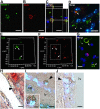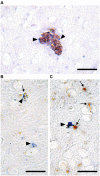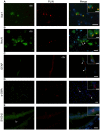Lipid-laden cells differentially distributed in the aging brain are functionally active and correspond to distinct phenotypes
- PMID: 27029648
- PMCID: PMC4814830
- DOI: 10.1038/srep23795
Lipid-laden cells differentially distributed in the aging brain are functionally active and correspond to distinct phenotypes
Abstract
We characterized cerebral Oil Red O-positive lipid-laden cells (LLC) of aging mice evaluating their distribution, morphology, density, functional activities and inflammatory phenotype. We identified LLC in meningeal, cortical and neurogenic brain regions. The density of cerebral LLC increased with age. LLC presenting small lipid droplets were visualized adjacent to blood vessels or deeper in the brain cortical and striatal parenchyma of aging mice. LLC with larger droplets were asymmetrically distributed in the cerebral ventricle walls, mainly located in the lateral wall. We also found that LLC in the subventricular region co-expressed beclin-1 or LC3, markers for autophagosome or autophagolysosome formation, and perilipin (PLIN), a lipid droplet-associated protein, suggesting lipophagic activity. Some cerebral LLC exhibited β galactosidase activity indicating a senescence phenotype. Moreover, we detected production of the pro-inflammatory cytokine TNF-α in cortical PLIN(+) LLC. Some cortical NeuN(+) neurons, GFAP(+) glia limitans astrocytes, Iba-1(+) microglia and S100β(+) ependymal cells expressed PLIN in the aging brain. Our findings suggest that cerebral LLC exhibit distinct cellular phenotypes and may participate in the age-associated neuroinflammatory processes.
Figures






References
-
- Franceschi C. et al.. Inflamm-aging. An evolutionary perspective on immunosenescence. Ann. N. Y. Acad. Sci. 908, 244–54 (2000). - PubMed
-
- Kirkland J. L., Tchkonia T., Pirtskhalava T., Han J. & Karagiannides I. Adipogenesis and aging: does aging make fat go MAD? Exp. Gerontol. 37, 757–767 (2002). - PubMed
Publication types
MeSH terms
Substances
LinkOut - more resources
Full Text Sources
Other Literature Sources
Medical
Miscellaneous

